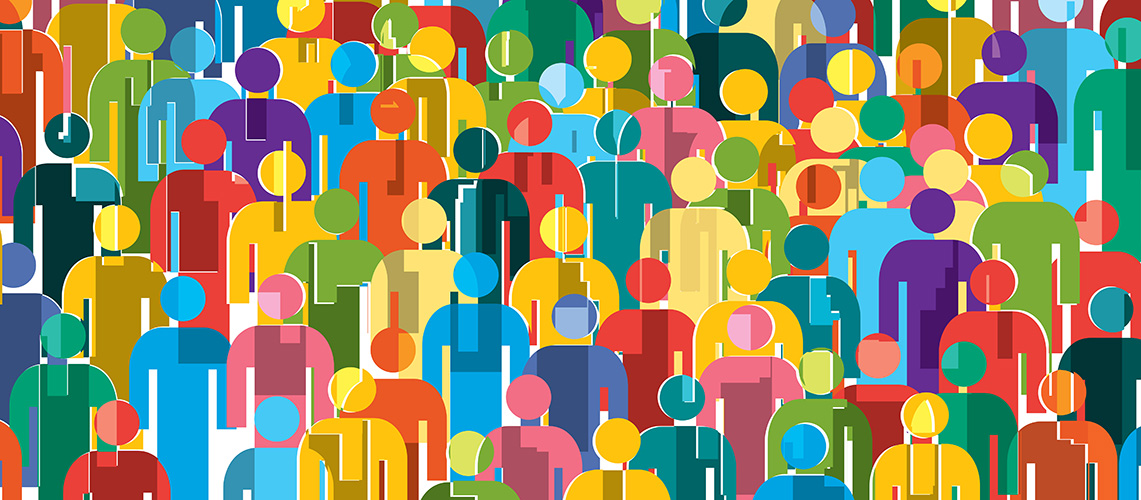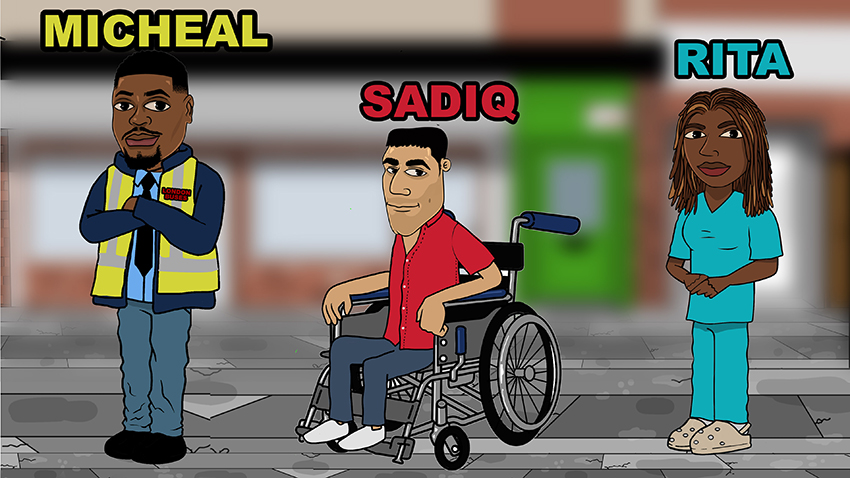 An illustration of a large group of people.
An illustration of a large group of people.Over the past 18 months, Impact on Urban Health has been working collaboratively to create a series of animations informed by real people practising community research in our area. The colleagues who have partnered with us to do this work include Centric Community Research and a creative team consisting of Gabriel Ajala of Geroff Visuals, Jide Johnson of Aniboxx and Sharon Brooks of Swiss Media UK.
The characters within the animations have been developed to showcase community research as a valuable methodology within the broad spectrum of qualitative research. In some forums, community research might be referred to as community-engaged research or community-based participatory research, but for our purposes, we are referring to it as community research. This initiative is part of the Shifting the Power in Research partnership with the Wellcome Trust, which aims to explore how community-centred research and funding models can help address health inequities in south London and beyond.
Ultimately, our goal is to make research more accessible to the communities we serve. In this blog post, I’ll outline the steps we are taking to achieve this, share the lessons we’ve learned along the way, and highlight how you can be part of this journey toward more inclusive and community-centred research.
The academic value of community research
In the evolving landscape of academic research, community research stands out as a powerful approach that bridges the gap between scholars and communities. By involving community members as active contributors within the research process, we can uncover deeper insights and foster more impactful outcomes. Our community research approach contributes to transformative practice by embracing mistakes, maintaining flexibility and appropriately resourcing contributors, all championing diverse forms of knowledge production.
What was our process?
Over a period of 34 weeks, we as a collective logged on virtually to Microsoft Teams to develop story ideas, design scripts and create characters through an iterative process of sharing and offering feedback. The community researchers were central to shaping the narratives, bringing their lived experiences and cultural insights to the forefront, which ensured that the stories were authentic and resonant with the intended audience.
The creative team complemented this by suggesting visually engaging scenes and potential techniques for enhancing emotional resonance and cultural authenticity in the final production. As a funder, our focus on health equity was paramount at every stage of the project. We helped to ensure that the stories developed were more than just entertainment; they became a platform for raising awareness, challenging inequities and promoting understanding.
This collaborative approach was invaluable for many reasons. First, it fostered a sense of ownership and empowerment among the community researchers, as they were not merely subjects of the storytelling but active co-creators. Their deep understanding of the community's nuances, challenges and strengths enriched the narratives, making them more relatable and impactful.
Secondly, the iterative process of sharing and offering feedback allowed for continuous refinement of ideas, ensuring that the final product was creatively compelling and socially relevant. It also allowed us to think about both narrative and impact, putting us in the shoes of content creators and enabling us to learn about the complexities of storytelling, the importance of audience engagement and the ways in which creative decisions can amplify the intended social impact. The creative team's expertise in visual storytelling further elevated the project by translating the researchers' insights into powerful, visually engaging scenes that could captivate and move the audience.
Ultimately, this iterative and partnership-driven approach highlighted the value of collaboration across disciplines and lived experiences, demonstrating that when diverse perspectives come together, the outcome is a richer, more nuanced and more effective form of storytelling that can inspire, educate and create meaningful change.
We’re now embarking on a journey with a learning partner to reflect on our experiences and growth throughout this process. This will enable us to understand what has worked well, identify areas for improvement and refine our approach to ensure more effective and meaningful community engagement in the future.
Archiving knowledge
As an organisation, we are committed to learning from our investments. Through testing various community research approaches, we are beginning to share our learning in multiple forums with our partners and the sector, enabling us to contribute to the conversation on co-design and co-production approaches. This knowledge ranges from course material to inform community research as a practice, to visual content that describes and illustrates ethical community research. Archiving this knowledge ensures that valuable insights are preserved and accessible for future academic and community use, fostering a culture of continuous learning and improvement.
Making participation a priority
We cannot do this work on our own, so we are actively investing in communities to support us in setting agendas and making decisions about the work we do in our place. We are exploring different devolved funding and decision-making models because working with communities, in comparison to working on communities, is vital to our work. By prioritising participation, we create a more inclusive research environment that respects and values the input of community members. This collaborative approach enriches the research process and empowers communities, giving them a voice and agency in shaping the outcomes that affect their lives.
Investing in creativity
While conventional mediums such as slide presentations remain valuable, we acknowledge the need for innovation. We know that not everyone learns in the same way. We are exploring the use of various creative means, such as photography, film, theatre and audio to help make our work more engaging and accessible. Investing in creativity allows us to communicate research findings in diverse and impactful ways, ensuring that our messages resonate with a broader audience. This creative engagement can lead to more profound and lasting connections with community members, enhancing the overall effectiveness of our research dissemination.

Our top three learnings
Producing great work through shared decision-making takes time
Although we initially planned for a six-month project, we found that we needed an additional 10-12 weeks to complete it. Effective collaboration requires patience and a commitment to long-term engagement, which can be challenging to sustain over an extended period. However, upon reflection, we recognise that building trust, understanding different perspectives and co-creating solutions takes time. To accommodate these needs, this may involve extending project timelines to ensure all voices are genuinely heard and considered in decision-making processes, as well as budgeting accurately for the extra time so that everyone is appropriately reimbursed.
Have regular check-ins, not just about the outputs but how people feel and are experiencing the space
Maintaining open communication is crucial for successful partnerships. While we held regular meetings every week, it’s important to dedicate sufficient time to acknowledge and reflect on the emotional well-being of participants and their experiences in the collaboration. This could involve creating structured spaces for feedback, such as reflection sessions, informal conversations or even monthly evaluation surveys, to ensure everyone feels supported and valued. Check-ins should focus not only on progress and outcomes but also on the people involved and their experiences in the space. Doing so enables the team to course-correct more effectively.
Being flexible in your approach is essential
Co-production and participation are inherently complex and can often feel messy or unpredictable, especially when power dynamics are at play. People want to be heard, respected and valued, and they also want to feel empowered to influence decisions, contribute meaningfully and see their input reflected in the outcomes. Being flexible means recognising that progress may not always be linear and being open to adjusting methods and expectations as new insights emerge.
Sharing our animations with the public
We are now working towards sharing these animations with the public through a series of in-person and online events. These events intend to spark dialogue with local people, illuminate the lived reality of health conditions and experiences, and engage stakeholders in recognising the multiple health dynamics at play when addressing health inequity. Our first dissemination event will be at the Healthy City Design 2024 International Congress, taking place in Liverpool in October 2024, where we will be sharing our work alongside colleagues in under theme of community impact. Here we will be presenting our animations, a paper and taking part in a panel discussion with other colleagues themed around community and public participation: tools, methods and impact.
By focusing on archiving knowledge, making participation a priority and investing in creativity, we aim to ensure that our community research work is rooted in harnessing the power of communities to support us in our mission of tackling health inequity.
Community research is more than a method; it is a philosophy that emphasises collaboration, respect and mutual learning. As we continue to navigate complex societal challenges, community research offers a promising path towards deeper understanding and meaningful change.

